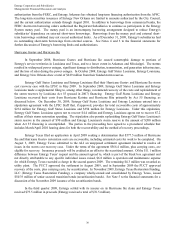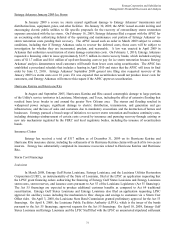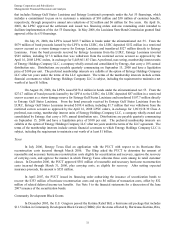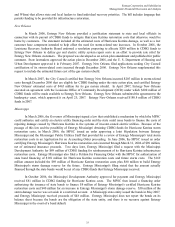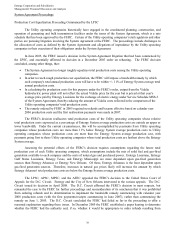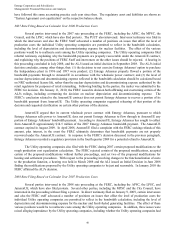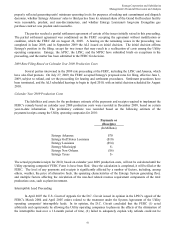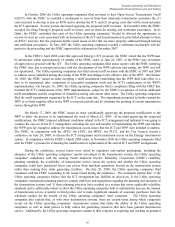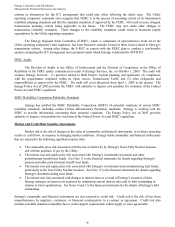Entergy 2009 Annual Report Download - page 42
Download and view the complete annual report
Please find page 42 of the 2009 Entergy annual report below. You can navigate through the pages in the report by either clicking on the pages listed below, or by using the keyword search tool below to find specific information within the annual report.Entergy Corporation and Subsidiaries
Management's Financial Discussion and Analysis
38
have followed this same accounting practice each year since then. The regulatory asset and liabilities are shown as
"System Agreement cost equalization" on the respective balance sheets.
2007 Rate Filing Based on Calendar Year 2006 Production Costs
Several parties intervened in the 2007 rate proceeding at the FERC, including the APSC, the MPSC, the
Council, and the LPSC, which have also filed protests. The PUCT also intervened. Intervenor testimony was filed in
which the intervenors and also the FERC Staff advocated a number of positions on issues that affect the level of
production costs the individual Utility operating companies are permitted to reflect in the bandwidth calculation,
including the level of depreciation and decommissioning expense for nuclear facilities. The effect of the various
positions would be to reallocate costs among the Utility operating companies. The Utility operating companies filed
rebuttal testimony explaining why the bandwidth payments are properly recoverable under the AmerenUE contract,
and explaining why the positions of FERC Staff and intervenors on the other issues should be rejected. A hearing in
this proceeding concluded in July 2008, and the ALJ issued an initial decision in September 2008. The ALJ's initial
decision concludes, among other things, that: (1) the decisions to not exercise Entergy Arkansas' option to purchase
the Independence plant in 1996 and 1997 were prudent; (2) Entergy Arkansas properly flowed a portion of the
bandwidth payments through to AmerenUE in accordance with the wholesale power contract; and (3) the level of
nuclear depreciation and decommissioning expense reflected in the bandwidth calculation should be calculated based
on NRC-authorized license life, rather than the nuclear depreciation and decommissioning expense authorized by the
retail regulators for purposes of retail ratemaking. Following briefing by the parties, the matter was submitted to the
FERC for decision. On January 11, 2010, the FERC issued its decision both affirming and overturning certain of the
ALJ's rulings, including overturning the decision on nuclear depreciation and decommissioning expense. The
FERC’ s conclusion related to the AmerenUE contract does not permit Entergy Arkansas to recover a portion of its
bandwidth payment from AmerenUE. The Utility operating companies requested rehearing of that portion of the
decision and requested clarification on certain other portions of the decision.
AmerenUE argued that its current wholesale power contract with Entergy Arkansas, pursuant to which
Entergy Arkansas sells power to AmerenUE, does not permit Entergy Arkansas to flow through to AmerenUE any
portion of Entergy Arkansas' bandwidth payment. According to AmerenUE, Entergy Arkansas has sought to collect
from AmerenUE approximately $14.5 million of the 2007 Entergy Arkansas bandwidth payment. The AmerenUE
contract expired in August 2009. In April 2008, AmerenUE filed a complaint with the FERC seeking refunds of this
amount, plus interest, in the event the FERC ultimately determines that bandwidth payments are not properly
recovered under the AmerenUE contract. In response to the FERC's decision discussed in the previous paragraph,
Entergy Arkansas recorded a regulatory provision in the fourth quarter 2009 for a potential refund to AmerenUE.
The Utility operating companies also filed with the FERC during 2007 certain proposed modifications to the
rough production cost equalization calculation. The FERC rejected certain of the proposed modifications, accepted
certain of the proposed modifications without further proceedings, and set two of the proposed modifications for
hearing and settlement procedures. With respect to the proceeding involving changes to the functionalization of costs
to the production function, a hearing was held in March 2008 and the ALJ issued an Initial Decision in June 2008
finding the modifications proposed by the Utility operating companies to be just and reasonable. In January 2010 the
FERC affirmed the ALJ's decision.
2008 Rate Filing Based on Calendar Year 2007 Production Costs
Several parties intervened in the 2008 rate proceeding at the FERC, including the APSC, the LPSC, and
AmerenUE, which have also filed protests. Several other parties, including the MPSC and the City Council, have
intervened in the proceeding without filing a protest. In direct testimony filed on January 9, 2009, certain intervenors
and also the FERC staff advocated a number of positions on issues that affect the level of production costs the
individual Utility operating companies are permitted to reflect in the bandwidth calculation, including the level of
depreciation and decommissioning expense for the nuclear and fossil-fueled generating facilities. The effect of these
various positions would be to reallocate costs among the Utility operating companies. In addition, three issues were
raised alleging imprudence by the Utility operating companies, including whether the Utility operating companies had
40


